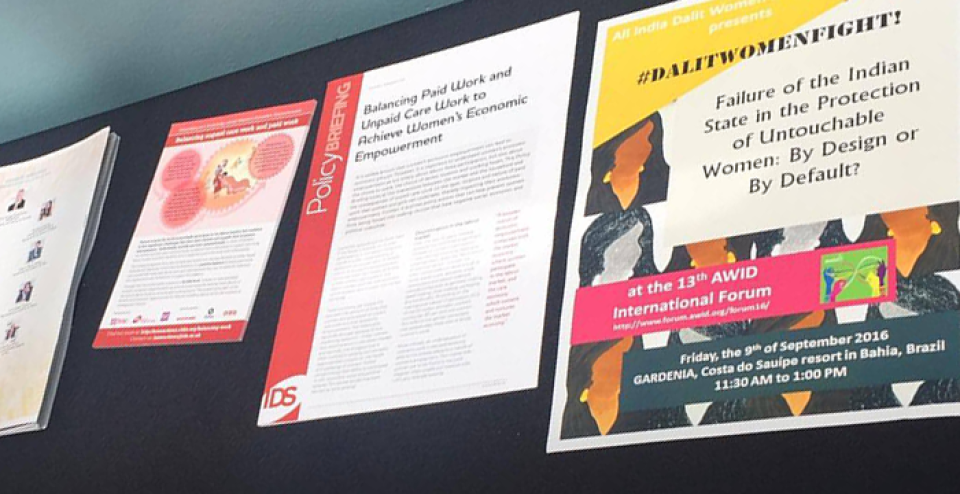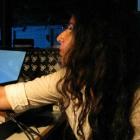
“There was something malevolent in the inequality, and now I knew it. It acted in the depths, it dug deeper than money.”
Elena Ferrante, The Story of the Lost Child
Drum beats resound around the ‘country’ that I come from. For those willing to listen, there is ferment brewing and people gathering to challenge and dismantle caste discrimination and hierarchies that have been prevalent for centuries. What was often relegated by many, including human rights organisations and the left political parties, to the periphery is making itself heard. Strongly, on its own terms, and to its own beat.
One of those incandescent groups is #Dalitwomenfight as supported by the All India Dalit Mahila Adhikar Manch, that did a session on caste based sexual violence at the AWID Forum 2016. Christina Dhanaraj, one of the organisers says, “This was the first participant-led session in AWID by Dalits” This year, there were in fact two such sessions. When asked about AWID, Christina says that it is in itself quite impressive. “People usually say Inclusive and intersectional when they have been anything but that. They are just words, but AWID was intentionally inclusive of several communities.”
Inclusive and intersectional are often just words, but AWID has been intentionally inclusive of several communities.
In such massive gatherings often the plenary session rings a bit empty or hollow, like background noise to other more real conversations taking place. AWID was different in that its burst of energy and radical politics was most often from the plenary sessions. The sex workers’ fashion show organised by a group from South Africa too was a refreshing blast of fun. The party churned with its own vibrant energy to the rhythms of the local diva-performer from Salvador in her golden dress, and then later when the DJ took over, there were loud demands for Beyonce. Our anthems are diverse, they are pop and popular and deep, they are local and unique – symbols of our autonomy.
One of the most stirring moments in the AWID forum was the panel organised on Rojava/Kobane women’s revolution & women’s self-defence. Here the struggle is with patriarchy, capitalism and the nation-state. The slogan of Kurdish women Jin Jiyani Azadi or Women Life Freedom succinctly communicates the core of their politics. One of the spokesperson Dilar Dirik speaks of how it is ordinary women who lead the revolution. She says, “It is my grandmother and my mother who know how to preserve ecology.” Their session on the last day is to a packed room, and the panelists speak in detail of how the system of democracy without a state or autonomy actually works. There are councils for each street and village led by both a woman and a man who are co-equal. They tell us how it is the women who do radical self-defense and have taken back their lands and villages from ISIS, and it is the women who have established an effective system for dealing with domestic violence. For those hungry for inspiration, there can be no other heartwarming story other than that of Rojava, whether it is for collectives for farming or it is for groups that want to set up autonomous communication networks.
Panelists in the session for Rojava/Kobane women’s revolution and women’s self defence speak in detail about how the system of democracy without a state actually works.
The Palestinian gay women’s organization Aswat also organise a well-attended session on pink washing, with the intent of combatting how the world perceives the settler-colonialism of Israel in Palestine. Israel masks various range of human rights violation and its brutality, by marketing itself as progressive and open to gay rights, especially through the production of films that circulate in queer festivals globally. When Audre Lorde says, “There is no thing as a single-issue struggle because we do not live single-issue lives”, this could well be one of the dichotomies that would illustrate this. What is in fact our stand on colonial occupations such as that of Israel in Palestine, India in Kashmir, of aggression towards and incarceration of black people in America, of caste brutality across South Asia and diaspora, of the exploitation and destruction of the ways of living of indigenous people in Latin America, of the murder of trans people in various parts of the world …
Earlier this year, Brazil had triumphantly led the resolution for the special rapporteur on sexual identity and gender expression at the 33rd Human Rights Council, but it is also the country with the highest number of trans women being killed already in the year 2016. But in contrast, at AWID there were multiple sessions for trans and intersex people. By day 2 the bathrooms were carrying notices stating that these are gender neutral spaces. I wonder about the individual experiences of trans and intersex people at AWID and whether these in some way did not align with the trans friendly space that AWID projected itself to be.

A lot of what happened in AWID seemed to happen in the periphery vision – glorious things like African yoga and sessions on aging and letting go, many of the photo exhibitions and stalls, the articulations and leftover energy from the Black Feminist Forum that preceded AWID, and the only functional internet connection run by the Feminist Internet Exchange Hub. Many movements seem to be turning to using technology, like women human rights defenders including the campaign for freeing Homa Hoofdar, who was finally released on 26th September. Another group Just Associates releases their toolkit for women human rights defenders at AWID. Christina speaks about how the campaign #dalitwomenfight, which has been spearheaded by Asha Kotwal and others, has allowed them to reach new audiences. She says, “Now a search for Dalits online leads us to many of the independent platforms and more positive imagery from campaigns.”
Glorious things like African yoga and sessions on aging and letting go, many of the photo exhibitions and stalls, the articulations and leftover energy from the Black Feminist Forum that preceded AWID, and the only functional internet connection run by the Feminist Internet Exchange Hub.
When talking about why this is the first Dalit-led session in AWID, Christina says, “The reason why Dalit women have not before been seen on their own terms in this space has less to do with AWID, and lots more to do with how savarna (dominant caste) feminism is in India and how it has influenced the agenda. While domestic violence, urban rape, sexuality, sex worker rights, disability are raised, caste is completely disregarded even when it obviously plays a profound role.” At the end of that session, a member of the audience, Romani academic and activist Kerieva McCormick speaks about how connected she felt to their cause. It is a poignant moment, as the movement for dignity for the Romanis and for Dalits, find in each other’s lived experience a mirror and solidarity with each other.
When I spoke to Kerieva she says that this was her first time at AWID, despite being involved in the Global Feminist movement for 15 years, (she was formally Women’s Officer at the ERRC) but Romani women have been coming to AWID for several years. More than 10 years ago, her colleague Enisa Eminova was a plenary speaker. Kerieva says, “It feels like we are picking up after a gap, and now we want to broaden our vision. Many of us have moved away from donor-led agendas towards more grassroots work. We were beginning to replicate the very system we were criticising, especially through hegemonic structures in NGOs.” She currently teaches at UWS, is a member of Romani Resistance and mentors young Romani women, and also speaks of how there are now LGBTQI Roma groups that are active.
Many of us have moved away from donor-led agendas towards more grassroots work. We were beginning to replicate the very system we were criticising, especially through hegemonic structures in NGOs.
Kerieva is passionate when she says, “We can’t be an island. Many years ago when some of us tried to make links with groups from other parts of the world, the mainstream of the Roma movement did not agree with us. But I believe that our collective power is with groups – if we want to imagine something progressive and collective, we have to communicate and organise with indigenous people, women of colour, take advice from civil rights movement in USA, learn from the two-spirit people from indigenous groups in Canada and the experience of First Nations women…
Our communities are under stress and we can’t do it alone.”
We can’t be an island.
Responses to this post
Ending extreme poverty and hunger is achievable, but the U.S. Government can’t do it alone. We need civil society partners with local connections, development expertise, and a passion for combatting hunger, poverty and undernutrition to help make it happen.
- Add new comment
- 38409 views






Add new comment